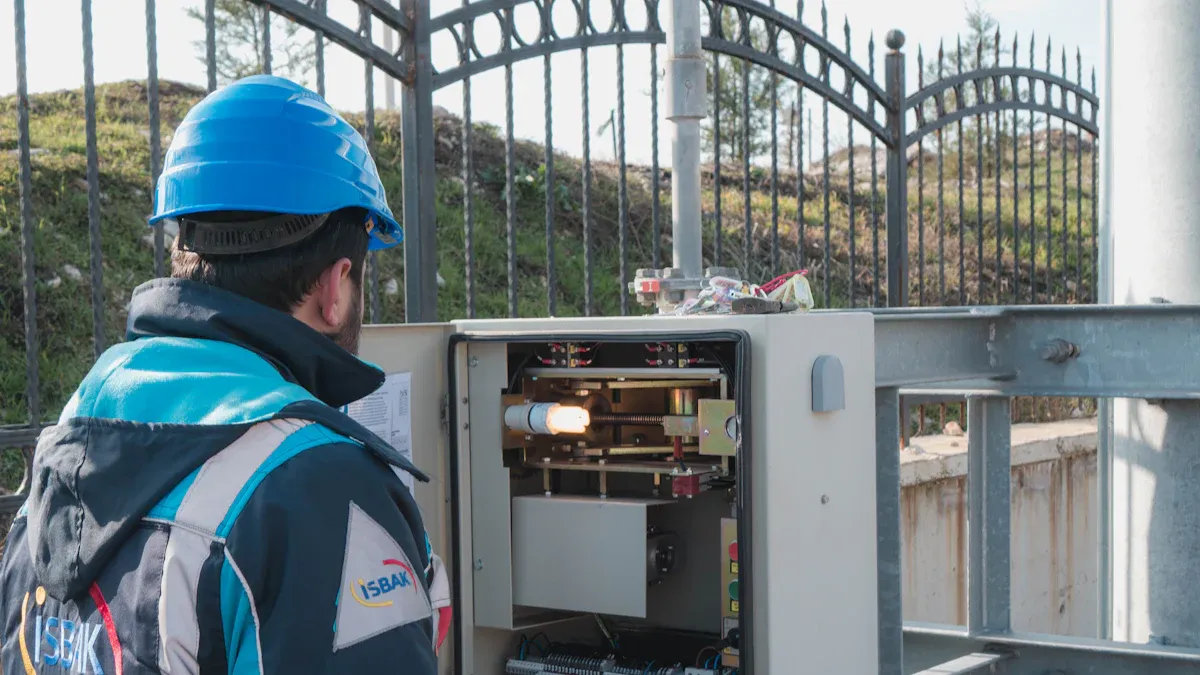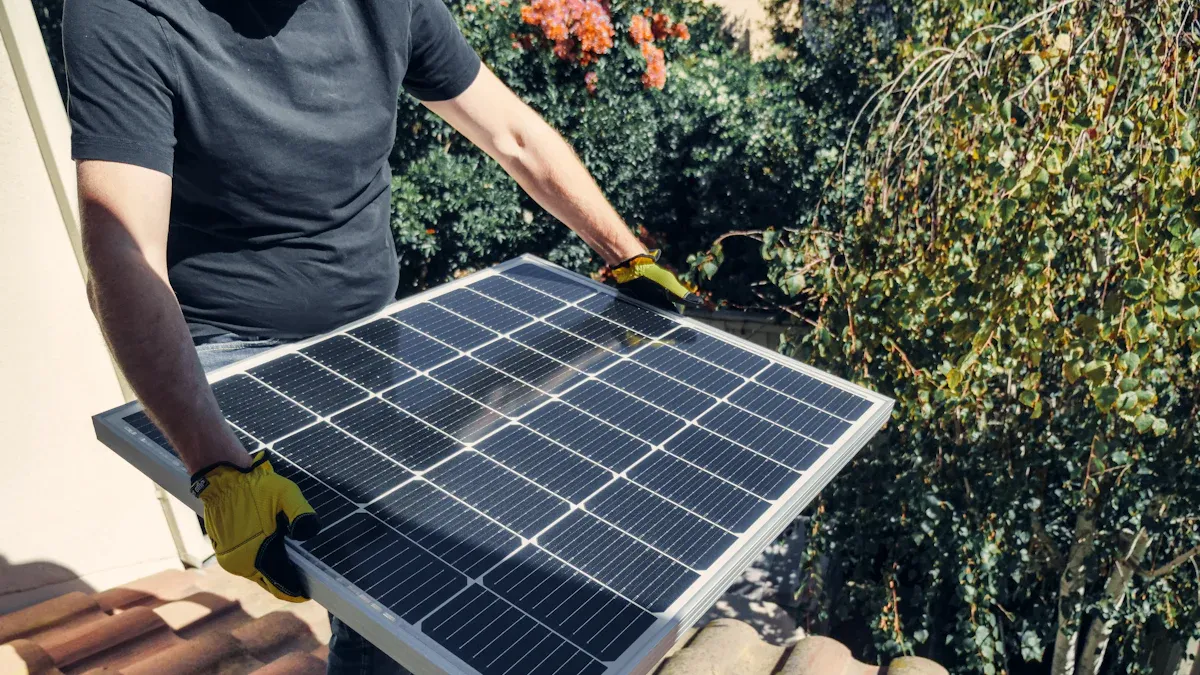Essential ESTEL Maintenance Tips for Outdoor Battery Cabinets in 2025

Maintaining your outdoor battery cabinet in extreme conditions is vital for its longevity and performance. Harsh weather, including intense heat, freezing temperatures, and heavy storms, can compromise the cabinet's integrity. Without proper care, you risk damage to the batteries and reduced efficiency. Proactive maintenance helps you avoid costly repairs and ensures uninterrupted power supply. Severe weather also brings challenges like moisture infiltration and physical damage, which demand your attention. Addressing these issues early keeps your equipment safe and operational year-round.
Key Takeaways
Check outdoor battery cabinets often to find problems early. Inspect them every three months or monthly in bad weather.
Pick cabinets made of strong materials like steel or aluminum. These materials don’t rust easily and handle tough weather well.
Use cooling methods to keep the cabinets at good temperatures. This stops overheating and helps batteries last longer.
Make sure cabinets are waterproof and don’t rust. Choose ones with good protection ratings, check seals, and use rust-proof coatings.
Add smart systems to watch cabinet conditions in real time. These systems spot problems early and make cabinets more reliable.
Challenges for Outdoor Battery Cabinets in Extreme Conditions

Risks from Temperature Fluctuations
Outdoor battery cabinets face significant challenges when exposed to extreme temperatures. High heat can lead to overheating, which accelerates battery degradation and reduces performance. On the other hand, freezing temperatures can cause the battery's chemical reactions to slow down, impacting its efficiency. Proper thermal management is essential to address these issues. You should ensure that the cabinet's design includes materials that optimize heat transfer and pressure release. This helps maintain a stable internal environment, even in fluctuating conditions.
Moisture and Humidity Concerns
Moisture and humidity pose serious risks to outdoor battery cabinets. Water intrusion can damage sensitive components and lead to rust or corrosion. High humidity levels can also compromise the battery's lifespan. To combat these challenges, you need to prioritize enclosures with high ingress protection (IP) ratings. These ratings ensure the cabinet can withstand water and dust infiltration. Regular inspections are also crucial to identify and address any signs of water damage early.
Debris and Dirt Accumulation
Debris and dirt can accumulate on and inside outdoor battery cabinets, especially in dusty or windy conditions. This buildup can block ventilation systems, leading to overheating and reduced efficiency. It can also interfere with the cabinet's structural integrity over time. Cleaning the cabinet regularly and ensuring proper ventilation are key steps to prevent these issues. You should also consider installing filters or screens to minimize the entry of debris into the cabinet.
Physical Damage from Severe Weather
Severe weather events, such as storms, hail, and high winds, can cause significant physical damage to outdoor battery cabinets. These conditions often lead to dents, cracks, or even structural failure, which compromise the cabinet's ability to protect its internal components. You must take proactive steps to minimize these risks and ensure the cabinet remains functional during extreme weather.
Tip: Inspect the cabinet's exterior after every major weather event. Look for visible signs of damage, such as dents or loose panels, and address them immediately to prevent further issues.
To protect your outdoor battery cabinet, focus on reinforcing its structural integrity. Choose cabinets made from durable materials like galvanized steel or aluminum, which resist impact and corrosion. Adding protective coatings or weather-resistant finishes further enhances their durability.
Wind-driven debris poses another threat during storms. Flying objects can strike the cabinet and cause physical damage. Installing barriers or shields around the cabinet reduces the risk of impact. You can also position the cabinet in a sheltered area to limit exposure to high winds.
Regular maintenance plays a crucial role in preventing long-term damage. Tighten loose screws and bolts to keep the cabinet secure. Replace worn-out seals and hinges to maintain its protective capabilities. These small actions help the cabinet withstand severe weather and extend its lifespan.
By prioritizing structural protection and conducting routine inspections, you safeguard your outdoor battery cabinet against physical damage caused by severe weather. This ensures uninterrupted performance and reduces repair costs over time.
Maintenance Tips for Outdoor Battery Cabinets
Thermal Management for Extreme Conditions
Managing heat is critical for the longevity and performance of outdoor battery cabinets. Excessive heat can degrade internal components, while extreme cold slows chemical reactions, reducing efficiency. You should prioritize thermal management to maintain optimal operating temperatures.
Modern cooling methods, such as Phase Change Materials (PCMs) and liquid cooling systems, offer effective solutions. PCMs absorb and transfer heat efficiently, helping regulate temperature fluctuations. Liquid cooling systems maintain temperature changes within 13ºC, ensuring batteries operate safely and efficiently. These technologies prevent overheating and extend battery life.
Routine maintenance is essential for identifying early signs of heat damage. Inspect the cabinet regularly for any signs of overheating, such as discoloration or unusual odors. Addressing these issues early ensures the cabinet remains functional during extreme conditions.
Tip: Install weatherproof covers to shield the cabinet from direct sunlight. This simple step reduces heat buildup and protects the internal components.
Waterproofing and Rust Prevention
Moisture is a significant threat to outdoor battery cabinets. Water intrusion can damage sensitive components, while rust and corrosion compromise the cabinet's structural integrity. To prevent these issues, you should focus on waterproofing and rust prevention.
Choose cabinets with high ingress protection (IP) ratings. These ratings indicate the cabinet's ability to resist water and dust infiltration. Weatherproof covers provide an additional layer of protection, keeping moisture out during heavy rain or snow.
Regular maintenance checks are crucial for spotting early signs of water damage. Look for rust, corrosion, or water stains inside the cabinet. Apply rust-resistant coatings to metal surfaces to enhance durability. Replace worn-out seals and gaskets promptly to maintain a watertight enclosure.
Note: Position the cabinet on an elevated platform to prevent water pooling during floods or heavy rainfall. This simple measure protects the cabinet from water damage.
Cleaning and Ventilation Practices
Dirt and debris can accumulate on and inside outdoor battery cabinets, blocking ventilation systems and causing overheating. Regular cleaning and proper ventilation practices are vital for maintaining the cabinet's efficiency.
Start by inspecting the cabinet's exterior for dirt, leaves, or other debris. Use a soft brush or cloth to clean the surface without scratching it. For the interior, ensure that ventilation openings remain unobstructed. Installing filters or screens can help minimize debris entry.
Proper airflow is essential for thermal management. Check the cabinet's ventilation system during maintenance checks to ensure it functions correctly. Replace clogged filters and clean fans to maintain optimal airflow.
Tip: Schedule cleaning sessions based on the local environment. Dusty or windy areas may require more frequent cleaning to prevent debris buildup.
By following these maintenance tips, you can protect your outdoor battery cabinets from extreme conditions. Regular inspections, cleaning, and proactive measures ensure the cabinets remain functional and efficient year-round.
Structural Protection Against Severe Weather
Protecting your outdoor battery cabinet from severe weather ensures its longevity and functionality. Extreme weather events, such as hurricanes, hailstorms, and heavy snowfall, can compromise the structural integrity of your cabinet. You can take several steps to safeguard it against these challenges.
Start by selecting a cabinet made from durable materials like galvanized steel or aluminum. These materials resist corrosion and withstand impacts from flying debris. Adding a weather-resistant coating further enhances the cabinet's ability to endure harsh conditions. Positioning the cabinet in a sheltered location, such as under an overhang or within a protective enclosure, reduces its exposure to high winds and heavy rain.
Reinforce the cabinet's structure by tightening screws, bolts, and hinges during routine maintenance. Replace worn-out seals and gaskets to maintain a secure and watertight enclosure. Installing barriers or shields around the cabinet can also minimize the risk of damage from wind-driven debris. For areas prone to flooding, elevate the cabinet on a sturdy platform to prevent water intrusion.
Tip: Consider using cabinets with reinforced doors and locks to protect against unauthorized access during severe weather events. This adds an extra layer of security to your storage system.
By implementing these measures, you can protect your cabinet from structural damage and ensure it continues to safeguard your batteries effectively.
Battery-Specific Maintenance Checks
Regular battery maintenance is essential for ensuring the safety and efficiency of your outdoor battery cabinet. Batteries are the heart of your power system, and neglecting their upkeep can lead to serious consequences. Minor faults, such as cell-level issues, can escalate into catastrophic failures like thermal runaway if not detected early. This makes routine maintenance checks a critical part of your system's operation.
Start by inspecting the batteries for visible signs of wear, such as swelling, leaks, or corrosion on the terminals. Clean the terminals using a soft cloth and a non-corrosive cleaning solution to prevent buildup that could affect performance. Check the battery connections to ensure they are secure and free from damage.
Monitoring the battery's temperature is another crucial step. Heat-related issues, such as overheating, can shorten the battery lifespan and lead to heat damage. Use real-time diagnostics or smart monitoring systems to track temperature fluctuations and identify potential problems early. These systems help you maintain proper heat management and prevent heat-related issues from escalating.
Note: Always follow the manufacturer's guidelines for battery maintenance. This ensures you use the correct procedures and tools for your specific battery type.
Testing the battery's voltage and capacity regularly helps you assess its performance and identify when it needs replacement. Keeping a log of these tests allows you to track the battery's health over time and make informed decisions about its storage and usage.
By prioritizing battery-specific maintenance checks, you can extend the battery lifespan, prevent operational failures, and ensure your power system remains reliable.
Proactive Measures for Outdoor Power Boxes
Regular Inspections and Maintenance Checks
Regular inspections are essential for keeping your outdoor power box in optimal condition. Extreme weather events, such as storms and heat waves, can cause significant wear and tear. By conducting frequent maintenance checks, you can identify potential issues early and prevent costly repairs.
Start by inspecting the exterior of the outdoor power box for visible damage, such as dents, rust, or loose panels. Check the seals and gaskets to ensure they remain watertight. Trim nearby trees and shrubs to reduce the risk of falling branches during storms. Secure the box properly to ensure stability during high winds.
Tip: Install a protective barrier around the box to shield it from flying debris. This simple step enhances its durability and reduces the risk of physical damage.
From 2011 to 2021, major power outages increased by 64%, highlighting the growing impact of extreme weather on outdoor power boxes. Regular inspections help you stay ahead of these challenges, ensuring uninterrupted performance.
Smart Monitoring Systems for Extreme Conditions
Smart monitoring systems provide real-time insights into the health and performance of your outdoor power box. These systems use advanced sensors to track environmental conditions, such as ambient temperature and humidity, enabling you to take proactive measures before issues arise.
For example, smart weather-tight electrical boxes come equipped with sensors that monitor ambient conditions and send alerts when thresholds are exceeded. Intelligent reclosers restore service during storms by operating in a pre-defined sequence, reducing downtime. Real-time weather monitoring enhances preparedness by providing accurate forecasts, allowing you to control temperatures and optimize cooling solutions.
Note: Investing in smart monitoring systems not only minimizes downtime but also extends the lifespan of your outdoor power box by preventing overheating and other weather-related damage.
Surge Protection for Severe Weather Events
Severe weather events, such as lightning storms, can cause power surges that damage your outdoor power box. Installing surge protection devices is a critical step in safeguarding your equipment. These devices absorb excess voltage, preventing it from reaching sensitive components.
Position the surge protector close to the outdoor power box for maximum effectiveness. Use models designed to handle high voltage levels, especially in areas prone to frequent storms. Combine surge protection with other measures, such as elevating the box to avoid water damage during floods.
Tip: Regularly test your surge protection devices during maintenance checks to ensure they remain functional. Replace them immediately if they show signs of wear or damage.
By implementing these proactive measures, you can protect your outdoor power box from extreme weather, ensuring reliable performance and reducing the risk of costly repairs.
Post-Severe Weather Maintenance for Outdoor Battery Cabinets

Inspection Checklist After Severe Weather
After a storm, inspecting your outdoor battery cabinet is essential to ensure it remains functional and safe. A thorough post-storm inspection helps you identify potential issues caused by severe weather. Follow this checklist to assess the condition of your cabinet:
Examine the Exterior: Look for visible damage such as dents, cracks, or scratches. Check for signs of water damage, including rust or discoloration on the surface.
Inspect Seals and Gaskets: Ensure all seals and gaskets remain intact and watertight. Replace any that appear worn or damaged.
Check for Debris: Remove any debris, such as leaves or branches, that may have accumulated around or inside the cabinet.
Assess Ventilation Openings: Confirm that ventilation systems are unobstructed and functioning properly.
Inspect Electrical Components: Look for loose wires, corrosion, or other signs of damage to the internal components.
Tip: Document your findings during the inspection. This record helps you track recurring issues and plan future maintenance.
Cleaning and Repair Procedures
Cleaning and repairing your outdoor battery cabinet after severe weather ensures it continues to operate efficiently. Start by removing any debris from the cabinet's exterior and surrounding area. Use a soft brush or cloth to clean the surface without causing scratches. For stubborn dirt, apply a mild cleaning solution and rinse with water.
Inspect the interior for signs of water damage. If you find moisture inside, dry the affected areas immediately using a clean, absorbent cloth. Replace any components that show signs of rust or corrosion.
Repair any structural damage, such as dents or cracks, to restore the cabinet's protective capabilities. Tighten loose screws and bolts to reinforce the cabinet's stability. Replace damaged seals and gaskets to maintain a watertight enclosure.
Note: Always use manufacturer-approved materials and tools for repairs. This ensures compatibility and prevents further damage.
Restoring Functionality and Performance
Once you complete the cleaning and repair process, focus on restoring the cabinet's functionality and performance. Begin by testing the electrical components to ensure they operate correctly. Check the battery connections for security and cleanliness.
Monitor the battery's voltage and capacity to confirm it meets the required specifications. Use diagnostic tools to identify any underlying issues that may affect performance. If necessary, replace damaged or degraded batteries to maintain optimal efficiency.
Tip: Consider installing a smart monitoring system to track the cabinet's performance in real time. This proactive measure helps you detect and address issues before they escalate.
Position the cabinet in a secure location to minimize exposure to future storms. Elevate it on a sturdy platform to prevent water damage during floods. Regular maintenance and monitoring ensure your outdoor battery cabinet remains reliable, even in extreme conditions.
Maintaining your ESTEL outdoor battery cabinets is essential for their longevity and performance. Proactive checks help you identify potential issues early, while post-event inspections ensure your system recovers quickly after severe weather.
Tip: Smart monitoring systems simplify maintenance by providing real-time updates on your cabinet's condition.
Regular inspections and adopting these tips protect your equipment from extreme conditions. By staying vigilant, you ensure uninterrupted power supply and extend the life of your outdoor power boxes. Take action today to safeguard your investment and maintain reliability year-round.
FAQ
What is the ideal frequency for inspecting outdoor battery cabinets?
You should inspect your outdoor battery cabinets at least once every three months. In areas with extreme weather, increase the frequency to monthly checks. Regular inspections help you identify potential issues early and prevent costly repairs.
How can I protect my battery cabinet from flooding?
Elevate the cabinet on a sturdy platform to keep it above potential flood levels. Use cabinets with high ingress protection (IP) ratings to prevent water intrusion. Regularly check seals and gaskets to ensure they remain watertight.
Are smart monitoring systems worth the investment?
Yes, smart monitoring systems provide real-time updates on your cabinet's condition. They help you detect issues like overheating or water intrusion early. This proactive approach reduces downtime and extends the lifespan of your equipment.
What materials are best for outdoor battery cabinets?
Choose cabinets made from galvanized steel or aluminum. These materials resist corrosion and withstand impacts from debris. Adding a weather-resistant coating enhances durability, ensuring the cabinet performs well in extreme conditions.
Can I clean the cabinet with any cleaning solution?
No, avoid harsh chemicals that may damage the cabinet's surface or internal components. Use a mild cleaning solution and a soft cloth for cleaning. Always follow the manufacturer's recommendations for safe and effective maintenance.
Tip: Keep a maintenance log to track inspections, repairs, and cleaning schedules. This helps you stay organized and ensures your cabinet remains in top condition.
See Also
Essential Strategies for Outdoor Telecom Cabinet Care
Surviving Weather Challenges: Tips for Outdoor Cabinets
Effective Maintenance Techniques for Outdoor Communication Cabinets
CALL US DIRECTLY
86-13752765943
3A-8, SHUIWAN 1979 SQUARE (PHASE II), NO.111, TAIZI ROAD,SHUIWAN COMMUNITY, ZHAOSHANG STREET, NANSHAN DISTRICT, SHENZHEN, GUANGDONG, CHINA


